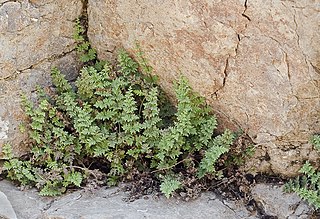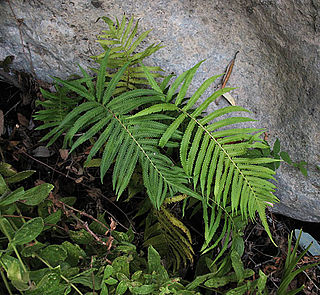
Pinus serotina, the pond pine, marsh pine or pocosin pine, is a pine tree found along the Southeastern portion of the Atlantic coastal plain of the United States, from southern New Jersey south to Florida and west to southern Alabama. This pine often has a crooked growth pattern and an irregular top and grows up to 21 metres (69 ft) high, rarely to 29 metres (95 ft).

Pinus clausa is a species of pine endemic to the Southeastern United States. Its common names include sand pine, Florida spruce pine, Alabama pine, and scrub pine.

Pinus ponderosa, commonly known as the ponderosa pine, bull pine, blackjack pine, western yellow-pine, or filipinus pine is a very large pine tree species of variable habitat native to mountainous regions of western North America. It is the most widely distributed pine species in North America.

Tsuga canadensis, also known as eastern hemlock, eastern hemlock-spruce, or Canadian hemlock, and in the French-speaking regions of Canada as pruche du Canada, is a coniferous tree native to eastern North America. It is the state tree of Pennsylvania. Eastern hemlocks are widespread throughout much of the Great Lakes region, the Appalachian Mountains, the Northeastern United States, and Maritime Canada. They have been introduced in the United Kingdom and mainland Europe, where they are used as ornamental trees.

Purshia tridentata, with the common name bitterbrush, is a shrub in the genus Purshia of the family Rosaceae. It is native to mountainous areas of western North America.

Cyperus polystachyos, also known as Pycreus polystachyos, and also called manyspike flatsedge in the US, or bunchy sedge, coast flatsedge, many-spiked sedge or Texas sedge in Australia, is a herbaceous species in the family Cyperaceae, widespread in tropical and subtropical areas around the world, sometimes extending its range into temperate regions.

Aspidotis is a small genus of leptosporangiate ferns known commonly as laceferns. Most species are native to slopes, ridges, and rocky outcroppings, primarily in California and Mexico, although one species included in the genus by some authorities is widely distributed in eastern Africa.

Stipa parishii, formerly classified as Achnatherum parishii, is a species of grass known by the common name Parish's needlegrass. The Jepson Manual 2nd edition (2012) reclassified the plant as Stipa parishii var. parishii.

Aspidotis californica is a species of fern known by the common name California lacefern. It is native to California and Baja California.

Aspidotis densa is a species of fern known by the common name Indian's dream or Serpentine fern. It is native to the west coast of North America from British Columbia to California and east to the Rocky Mountains in Idaho, Montana, and Wyoming; there is a disjunct population on serpentine soils in Quebec.

Asplenium septentrionale is a species of fern known by the common names northern spleenwort and forked spleenwort. It is native to Europe, Asia and western North America, where it grows on rocks. Its long, slender leaves give it a distinctive appearance. Three subspecies exist, corresponding to a tetraploid and a diploid cytotype and their triploid hybrid.

Myriopteris viscida, formerly known as Cheilanthes viscida, is a species of lip fern known by the common names viscid lip fern and viscid lace fern.

Amauropelta noveboracensis, the New York fern, is a perennial species of fern found throughout the eastern United States and Canada, from Louisiana to Newfoundland, but most concentrated within Appalachia and the Atlantic Northeast. New York ferns often forms spreading colonies within the forests they inhabit.

Pteris tremula, commonly known as Australian brake, tender brake, tender brakefern, shaking brake is a fern species of the family Pteridaceae native to sheltered areas and forests in eastern Australia and New Zealand. It has pale green, lacy fronds of up to 2 meters in length, with an erect, tufted rhizome that is covered with narrow brown scales. It is fast-growing and easy to grow in cultivation, but can become weedy.

Adiantum formosum, known as the giant maidenhair or black stem maidenhair is a fern found in Australia and New Zealand. It was one of the many species authored by Scottish botanist Robert Brown, appearing in his 1810 work Prodromus Florae Novae Hollandiae et Insulae Van Diemen. Its species name is the Latin adjective formosus "handsome" or "beautiful".

Christella puberula, synonym Thelypteris puberula, is a species of fern known by the common name showy maiden fern. The variety Ch. puberula var. sonorensis is known by the common name Sonoran maiden fern.

Dicranopteris linearis is a common species of fern known by many common names, including Old World forked fern, uluhe (Hawaiian), and dilim (Filipino). It is one of the most widely distributed ferns of the wet Old World tropics and adjacent regions, including Polynesia and the Pacific. In parts of the New World tropics its niche is filled by its relative, Dicranopteris pectinatus.

Adiantum viridimontanum, commonly known as Green Mountain maidenhair fern, is a rare fern found only in outcrops of serpentine rock in New England and Eastern Canada. The leaf blade is cut into finger-like segments, themselves once-divided, which are borne on the outer side of a curved, dark, glossy rachis. These finger-like segments are not individual leaves, but parts of a single compound leaf. The "fingers" may be drooping or erect, depending on whether the individual fern grows in shade or sunlight. Spores are borne under false indusia at the edge of the subdivisions of the leaf, a characteristic unique to the genus Adiantum.

Vandenboschia boschiana, synonym Trichomanes boschianum, the Appalachian bristle fern or Appalachian filmy fern, is a small delicate perennial leptosporangiate fern which forms colonies with long, black creeping rhizomes. The evergreen fronds are bipinnatifid, deeply and irregularly dissected, about 4 to 20 cm long, 1 to 4 cm across with winged stipes 1 to 7 cm long and light green in colour. The common name derives from the leaves which are very thin, only a single cell thick, missing an epidermis and translucent, giving the appearance of a wet film.
Carlotta Case Hall was an American botanist and university professor who collected and published on ferns. She also co-authored a handbook on the plants of Yosemite National Park.




















